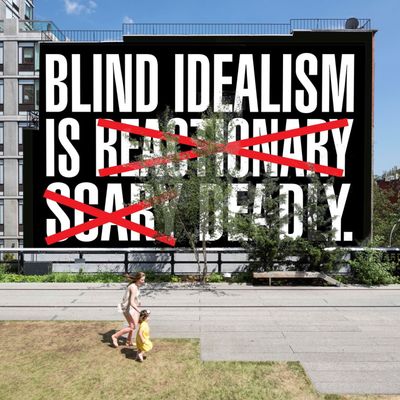
“There’s no such thing as security anywhere; we live in a porous world,” says the artist Barbara Kruger. It’s Tuesday morning, and we’d been scheduled since the previous week to talk about a new mural she’d been commissioned to create for the High Line, but we were distracted, absorbing the news of the terror attacks in Brussels, relating it, as we always do, to our own lives: the explosion on the subway there (“I take the subway six times a day,” in New York, she says, “and everyone is there with their backpacks … ”) and at the airport, which makes her think about her flight home to Los Angeles tomorrow. But Kruger is, if not resigned exactly, realistic: “There’s no way to protect yourself,” she says. “People acting out pathologies and ideologies gone amuck, and gang warfare gone worldwide … ”
Wait, what were we supposed to be talking about? Oh, yes, her mural, called Untitled (Blind Idealism Is…). “We were talking about it,” Kruger says, and she’s right: In all-caps white letters, it reads, “BLIND IDEALISM IS REACTIONARY SCARY DEADLY,” with two of the last three words crossed out, as if revealing her anxious thought process. The original quote — “Blind idealism is reactionary” — came from Afro-Caribbean philosopher and postcolonial revolutionary thinker Frantz Fanon (1925–61), whom Kruger describes as “prescient in some ways.” She’d used it before, in its non-redacted form, in 2007 for a project with The Guardian. “It was printed on a wrapping, which people could do what they want with,” she says. (Like wrapping presents: Happy Marxmas!)
Today’s sickening and bewildering act of terrorism is tomorrow’s fish wrap, of course — the world doesn’t seem to be running out of the potential for generating terrible events anyway. Meanwhile, her mural, and its message, had been long in the making. “Even without global terrorism, we have our electoral flunkies to deal with,” she notes, speaking mostly (but not only) of Donald Trump. “I remember years ago I used Karl Kraus’s ‘The secret of the demagogue is to make himself as stupid as his audience so they believe they are clever as he,’” in another one of her quote-based text pieces, she says. “I changed the his to her, because of Palin.”
Trump is “just a narcissistic child opportunist. But no one said that should disqualify you to be president,” she says. “He’s just a mix of thug and clown, an injured damaged child in a playground who knows how to hurt other children.” Still, she was interested to see him take down the Bushes and the “conventional Republicans.”
It’s not only a right-wing problem, as she diagnoses it. “I don’t love any candidates. People think they should love their candidates.” But she thinks that’s ridiculous. It’s not that she’s against idealism — she just advocates “reality testing” it.
“The whole idea of blind idealism is pretty broad,” she says. “The motor of blind idealism is when people say they’re voting with their conscience — which makes me sick; it’s so narcissistic — rather than voting strategically.”
The redaction process on the Fanon quote was to have it evolve from the language of (somewhat retrograde) political discourse and “go to the vernacular, which is fear. Open it up.”
Just to clarify: “I don’t think I make political work. I try to make the work for how we are to one another. This comes into that phylum of consideration. I’m interested in doubt, which can puncture blind idealism.”
Kruger left New York for Los Angeles in the late 1970s, but she comes back often. Cecilia Alemani, the curator of High Line Art, approached her about doing something a year ago. The mural is hand-painted (by a sign company that specializes in this retro-artisanal advertising) on the side of a building at 22nd Street (most recently it was the site of a droll real-estate sci-fi vision by Kerry James Marshall). Kruger was intrigued by the fact that the wall is opposite a set of risers designed for touristic rest and contemplation. “I thought it was a good context for this,” given the number of “pedestrian eyes” in that area. “It’s a good place to address people.” It’s also perfectly Instagrammable. “Everyone takes pictures of everything. They can’t experience anything without looking through a screen.”





























